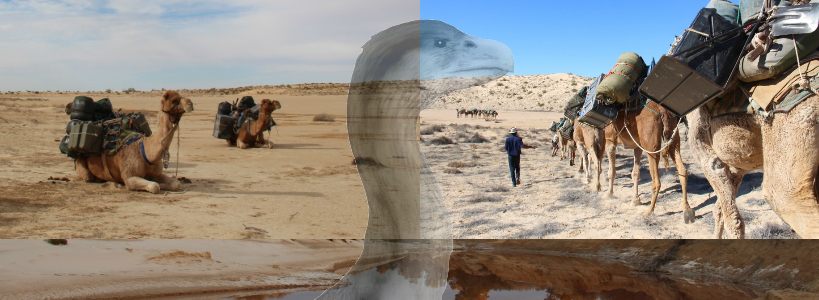Extinct Megafauna, Camels, and the Australian Desert: the 2014 Simpson Desert Palaeontology Expedition
Dr Jillian Garvey
ARC DECRA Fellow, Faculty of Humanities and Social Sciences, LaTrobe University
The story of camels being used for inland exploration in Australia began when the Royal Society of Victoria imported camels for the Victorian Exploring Expedition (later titled the Burke and Wills Expedition).
This tradition of camel expeditions has been revived in recent years by Australian Desert Expeditions (ADE). During their inaugural Arid River Expeditions in 2007 several extinct megafauna fossil sites were recorded. One of these localities in the southern Simpson Desert, on the Kalakoopah River, was believed to represent an articulated skeleton of Genyornis newtoni, the last of the large, flightless mihirungs or ‘thunder birds’ which were very large heavily built birds that grew to more than two metres.
This fossil was potentially very important, as it was thought to represent the most complete skeleton known. However, due to major floods in 2009 and 2010 ADE were unable to access this part of the desert. In July 2014, a special two week Simpson Desert Palaeontology Expedition was planned to walk back to the fossil site along the Kalakoopah River to try and excavate and retrieve as much of the skeleton as possible. Whilst the fossil did not represent Genyornis newtoni it was found to be far more significant and rare. This talk will highlight this expedition: the first camel expedition to transport palaeontological material from the inland deserts of Australia in more than a century.
About the Speaker
Dr Jillian Garvey is an Australian Research Council DECRA Fellow investigating human occupation and use of the landscape in the late Quaternary of the central Murray River valley, in northwest Victoria. With a background in zoology and archaeology her main research focus is on the role of animals in Australian archaeology. She has integrated her zoological background into research on modern Australian vertebrates and invertebrates by conducting experiments including: fatty acid nutritional analyses; economic utility or anatomy experiments; and butchery and cooking experiments. These modern experiments are combined with evidence from the ethnographic record to provide an interpretation of patterns in the archaeological record. With a PhD in palaeontology, Jillian is also interested in studying natural faunal assemblages, and what this can infer about past palaeoenvironments and palaeoecology. In particular she is interested in the causes behind the extinction of Australia’s megafauna during the late Pleistocene era.







